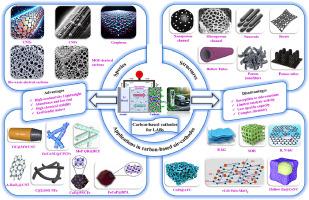当前位置:
X-MOL 学术
›
Energy Storage Mater.
›
论文详情
Our official English website, www.x-mol.net, welcomes your
feedback! (Note: you will need to create a separate account there.)
A comprehensive review of carbon-based air cathode materials for advanced non-aqueous lithium–air batteries
Energy Storage Materials ( IF 18.9 ) Pub Date : 2024-10-30 , DOI: 10.1016/j.ensm.2024.103874 Amol M. Kale, Seul-Yi Lee, Soo-Jin Park
Energy Storage Materials ( IF 18.9 ) Pub Date : 2024-10-30 , DOI: 10.1016/j.ensm.2024.103874 Amol M. Kale, Seul-Yi Lee, Soo-Jin Park

|
Lithium–air batteries (LABs) present a promising solution for future energy storage due to their exceptional energy density and potential to address imminent energy and environmental challenges. The complicated generation and breakdown of Li2 O2 at the air-cathode is the main cause of the durability and stability problems that LABs encounter. These problems are not merely related to low catalytic efficiency; instead, problems are made worse by restricted charge/discharge reversibility along with side-product generation in open-air. Furthermore, the function of solid‒phase electrocatalysts is still controversial, particularly when Li2 O2 generation is involved. This makes the hunt for efficient air-cathode materials more challenging. Since their inception in 1996, carbon has been crucial in advancing LAB technology, enhancing our understanding of its mechanisms and applications. This review examines advances in carbon materials and chemistry for LABs, focusing on structural characteristics, electrochemical behavior, and mechanistic insights. Air-cathode materials are categorized into carbon nanotubes (CNTs), carbon nanofibers (CNFs), graphene, bio-waste-derived carbons, and metal–organic frameworks (MOFs)-derived carbons. Additionally, the review evaluates the design, synthesis strategies, and electrochemical performance of these carbon-based air-cathode materials. It also explores oxygen-selective membranes (OSMs) as a potential solution to mitigate the adverse effects of H2 O and CO2 in ambient air, which lead to the formation of Li2 O2 and reactions with the electrolyte and Li anode in open-air systems. In conclusion, this review addresses the current challenges faced by LABs and highlights the potential for further research and development in this field.
中文翻译:

用于先进非水基锂-空气电池的碳基空气正极材料综述
锂空气电池 (LAB) 因其卓越的能量密度和应对迫在眉睫的能源和环境挑战的潜力,为未来的储能提供了一种有前途的解决方案。Li2O2 在空气阴极处的复杂生成和击穿是 LAB 遇到耐久性和稳定性问题的主要原因。这些问题不仅与低催化效率有关;相反,受限的充电/放电可逆性以及露天副产物的产生使问题变得更糟。此外,固相电催化剂的功能仍然存在争议,特别是当涉及 Li2O2 生成时。这使得寻找高效的空气阴极材料更具挑战性。自 1996 年成立以来,碳在推进 LAB 技术、增强我们对其机制和应用的理解方面一直发挥着关键作用。这篇综述研究了 LAB 的碳材料和化学进展,重点关注结构特性、电化学行为和机理见解。空气阴极材料分为碳纳米管 (CNT)、碳纳米纤维 (CNF)、石墨烯、生物废物衍生碳和金属有机框架 (MOF) 衍生碳。此外,该综述还评估了这些碳基空气阴极材料的设计、合成策略和电化学性能。它还探索了氧选择性膜 (OSM) 作为减轻环境空气中 H2O 和 CO2 不利影响的潜在解决方案,这些不利影响会导致 Li2O2 的形成以及与露天系统中的电解质和锂阳极反应。总之,本综述解决了 LABs 当前面临的挑战,并强调了该领域进一步研究和开发的潜力。
更新日期:2024-10-30
中文翻译:

用于先进非水基锂-空气电池的碳基空气正极材料综述
锂空气电池 (LAB) 因其卓越的能量密度和应对迫在眉睫的能源和环境挑战的潜力,为未来的储能提供了一种有前途的解决方案。Li2O2 在空气阴极处的复杂生成和击穿是 LAB 遇到耐久性和稳定性问题的主要原因。这些问题不仅与低催化效率有关;相反,受限的充电/放电可逆性以及露天副产物的产生使问题变得更糟。此外,固相电催化剂的功能仍然存在争议,特别是当涉及 Li2O2 生成时。这使得寻找高效的空气阴极材料更具挑战性。自 1996 年成立以来,碳在推进 LAB 技术、增强我们对其机制和应用的理解方面一直发挥着关键作用。这篇综述研究了 LAB 的碳材料和化学进展,重点关注结构特性、电化学行为和机理见解。空气阴极材料分为碳纳米管 (CNT)、碳纳米纤维 (CNF)、石墨烯、生物废物衍生碳和金属有机框架 (MOF) 衍生碳。此外,该综述还评估了这些碳基空气阴极材料的设计、合成策略和电化学性能。它还探索了氧选择性膜 (OSM) 作为减轻环境空气中 H2O 和 CO2 不利影响的潜在解决方案,这些不利影响会导致 Li2O2 的形成以及与露天系统中的电解质和锂阳极反应。总之,本综述解决了 LABs 当前面临的挑战,并强调了该领域进一步研究和开发的潜力。


















































 京公网安备 11010802027423号
京公网安备 11010802027423号